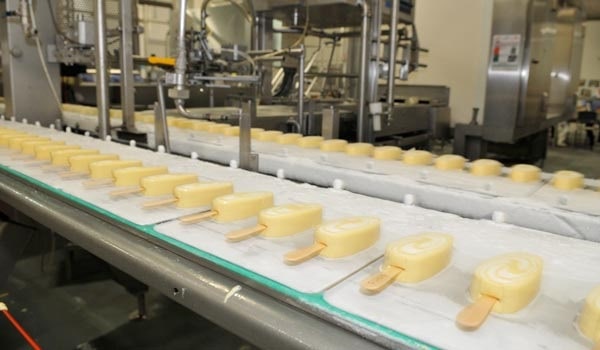Ice cream is a dairy product or a delicious, pleasant and pleasant fruit juice that has many consumers in all seasons, especially spring and summer, if the ice cream is prepared and packaged in a hygienic manner and in accordance with standard principles and consumed by hand. Reach is very popular
Ice cream production stages
Pasteurization
Homogenization
Freezing
packing
Harden

The following is a brief description of the ice cream production process:
1- Mixing
At this stage, the ingredients are selected according to the ice cream recipe. The materials are then weighed based on dry weight to obtain a specific composition after mixing.
To mix the raw materials, the container containing the mixture must be shaken vigorously so that the powder compounds are evenly mixed with the liquid materials. For this reason, high-speed mixers are often used
2- Pasteurization
At this stage, the resulting mixture is pasteurized. The pasteurization process is a biological control step based on the complete destruction of pathogenic bacteria.
In addition, the pasteurization process is effective in reducing the number of spoilage germs such as psychotropes and on the other hand helps to hydrate some compounds such as proteins and stabilizers.
A temperature of 69 ° C for 30 minutes or 80 ° C for 25 seconds is required to produce these properties.
Both non-continuous and continuous (HTST) methods are used in this process.
In the non-continuous pasteurization method, the raw materials are mixed in a large covered tank. This tank is equipped with a steam or hot water heating system
The ice cream mixture in this tank is heated to at least 69 degrees Celsius and then left at this temperature for 30 minutes.
In this case, the pathogenic bacteria are completely destroyed and the total number of bacteria is reduced to a maximum of one hundred thousand per gram.
After pasteurization, the mixture is homogenized and then cooled by passing through several types of heat exchangers and reaching a temperature of 4 degrees Celsius.
But in continuous pasteurization system, high heat and short time are used.
In this system, the materials are heated to about 30-40 degrees Celsius after being mixed in a large, separate tank with some preheating systems. This heat is necessary for the materials to combine with each other.
The continuous pasteurization system is equipped with a heating section, a cooling section and a reduction section. The cooling section of this system for ice cream is usually larger than the cooling system of milk.
3- Homogenization:
After pasteurization, the mixture becomes homogeneous, in which case a fat emulsion is formed as a result of breaking down or reducing the amount of fat cells in milk or cream to less than 1 mm.
Two-stage homogenization systems are commonly used for ice cream mixes.
Evidence has shown that the use of single-stage homogenizers causes fat cells to clump as they cool, which increases viscosity, slows down, and decreases volume.
But these disadvantages disappear in two-stage homogenization.
Benefits of homogenization:
1- Reducing the amount of fat cells
2- Increasing the contact level
3- Membrane formation
4- Possibility of using frozen butter and cream
5- Softness and uniformity of ice cream texture
6- Better air stability
7- Increasing the resistance of ice cream to melting
The homogenization process should be done at the same pasteurization temperature. Because high heat prevents the breakdown of fat cells at any pressure and prevents the accumulation and clustering of fat
The optimum pressure varies according to the composition of the mixture, but generally in two-stage homogenizers, a pressure of 2000-2500 psi in the first stage and 500-1000 psi in the second stage is the desired characteristic in most cases.
Another point that can be said is the form of ice cream molds. Today, some companies offer their products in various forms and a mixture of different flavors to attract customers.
To produce such products, new technologies are needed, for example, in the preparation of fruit ice cream, a mixture of 2 or 3 types of fruit is involved, which is injected into ice cream liquid ice cream molds and is produced after freezing the desired product.
Therefore, conventional technologies in ice cream production can be divided into 3 categories: traditional technology that is common in shops and stores in cities and produces ice cream locally, a medium technology that is used by most small houses in the country. , High technology used by most large factories in the country and their products are known in the community.
Source:sanaat


difference entre cialis et levitra https://newfasttadalafil.com/ – Cialis Bvpafd formation Prix Cialis En Pharmacie France Cialis https://newfasttadalafil.com/ – cialis buy online usa Xpnjzd Propecia Sin Receta